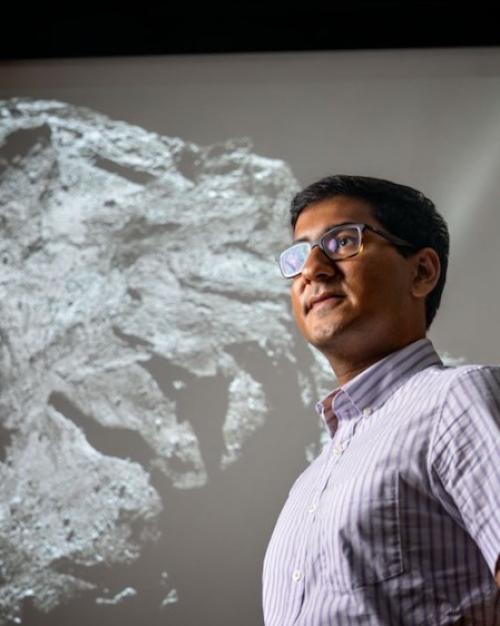With an eye toward a possible return mission years in the future, Cornell astronomers have shown how smooth terrains – a good place to land a spacecraft and to scoop up samples – evolve on the icy world of comets.
By applying thermal models to data gathered by the Rosetta mission – which caught up to the barbell-shaped Comet 67P/Churyumov–Gerasimenko almost a decade ago – they show that the topography influences the comet’s surface activity across hundreds of meters.
The research was published Aug. 16 in the Planetary Science Journal.
“You can have a uniform surface composition on comets and still have hotspots of activity,” said lead author Abhinav S. Jindal, a graduate student in astronomy and member of the research group of Alexander Hayes, ’03, M.Eng. ’03, associate professor of astronomy in the College of Arts and Sciences. “The topography is driving the activity.”
Comets are icy bodies made of dust, rocks and gas left over from the solar system’s formation about 4.6 billion years ago, Jindal said. They form in the solar system’s outer fringes and have spent eternity cruising through the dark, cosmic freezer of space, far from the sun’s heat.
“Their chemistry has not changed much from when comets formed, making them ‘time capsules’ preserving primordial material from the birth of the solar system,” Jindal said, explaining that these bodies likely seeded early Earth with water and key building blocks of life.
“As some of these comets have been pulled into the inner solar system,” he said, “their surfaces undergo changes. Science is trying to understand the driving processes.”
As Comet 67P loops its way back toward the sun, as it does every 6.45 years, the body speeds by it to a point called perihelion – its closest approach – and the comet warms up. The Rosetta mission followed the comet as it rounded the sun, and studied its activity. The smooth terrains serve as locations where the most changes were observed, making them key to grasping the surface’s evolution.
Jindal and the researchers examined the evolution of 16 topographic depressions in the Imhotep region – the largest smooth terrain deposit on 67P – between June 5, 2015, when activity was first observed, and Dec. 6, 2015, when the final large-scale changes were observed, Jindal said.
The comet went through a process called sublimation – in which the icy parts turned gaseous in the sun’s heat. The comet’s smooth Imhotep region showed a complex pattern of simultaneous eroding scarps (the steep edges of arc-shaped depressions) and material deposition.
The European Space Agency’s Rosetta mission launched in March 2004, equipped with comet-landing craft named Philae. The spacecraft bided its time by exploring Mars and a few asteroids, and a decade after launch, Rosetta arrived at Comet 67P to chaperone the object as it rounded the sun. Its smaller, drone-like Philae craft landed on the comet in late 2014; Rosetta plunged to the surface in late 2016.
Jindal believes science will one day return to Comet 67P. “These comets are helping us to answer the question of where we come from,” he said.
In addition to Jindal and Hayes, co-authors of “Topographically Influenced Evolution of Large-scale Changes in Comet 67P/ Churyumov–Gerasimenkoʼs Imhotep Region” include Samuel P. D. Birch, Ph.D. ’18, and Jason M. Soderblom, Ph.D. ’07, both of the Massachusetts Institute of Technology.
Both Hayes and Jindal are members of Cornell’s Carl Sagan Institute.
This research was supported by the Rosetta Data Analysis Program and the Heising-Simons Foundation.





